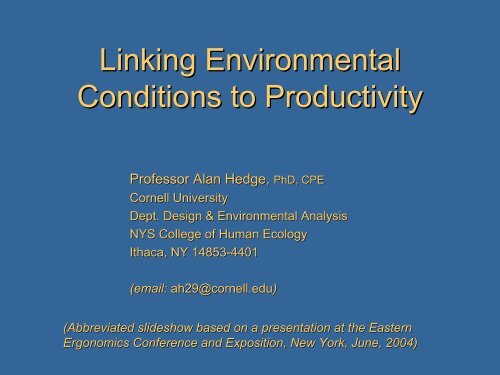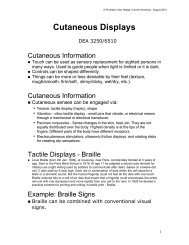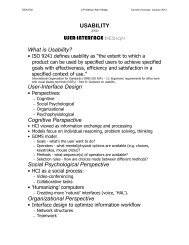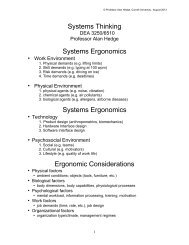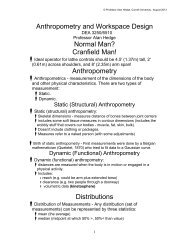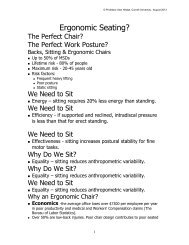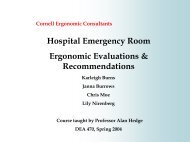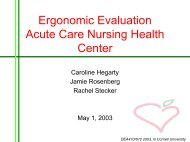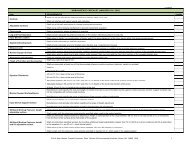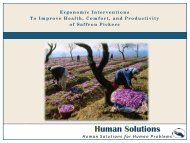Linking Environmental Conditions and Productivity - Cornell ...
Linking Environmental Conditions and Productivity - Cornell ...
Linking Environmental Conditions and Productivity - Cornell ...
- No tags were found...
Create successful ePaper yourself
Turn your PDF publications into a flip-book with our unique Google optimized e-Paper software.
<strong>Linking</strong> <strong>Environmental</strong><strong>Conditions</strong> to <strong>Productivity</strong>Professor Alan Hedge, PhD, CPE<strong>Cornell</strong> UniversityDept. Design & <strong>Environmental</strong> AnalysisNYS College of Human EcologyIthaca, NY 14853-44014401(email: ah29@cornell.edu)(Abbreviated slideshow based on a presentation at the EasternErgonomics Conference <strong>and</strong> Exposition, New York, June, 2004)
IEQ Effects on <strong>Productivity</strong>• Scattered studies that mostly show evidence ofan association between indoor environmentconditions <strong>and</strong> some measure of performance.• Research issues:– Laboratory vs. field studies– Single vs. multiple contaminants/conditions– Surveys vs. interventions– Short-term term vs. longer-term– Single exposure vs. multiple exposure– Time-lagged effects– Acute vs. chronic health effects
IEQ Effects on <strong>Productivity</strong>SystemHeating,Ventilating <strong>and</strong>Air ConditioningSystem<strong>Environmental</strong>experience• Thermal comfort• Indoor Air Quality• Background noise• Mechanicalvibration• Personalcontrol/stress<strong>Productivity</strong> Impact• Performance decreases when too cold• Performance decreases when too hot• Performance decreases in polluted air• Performance decreases when too noisy• Performance decreases whenperson/equipment vibrates• Performance decreases with no control(perceived or real)
IEQ Effects on <strong>Productivity</strong>SystemLighting System<strong>Environmental</strong>experience• Illumination level/distribution• Glare• Ambient/tasksystems• Color• Room ambience(shadows)• Personalcontrol/stress<strong>Productivity</strong> Impact• Performance decreases when too dim ortoo bright• Performance decreases when too glaring• Task dem<strong>and</strong>s <strong>and</strong> user age change lightrequirements• Affective changes in environmentaldesirability• Disrupts visual inspection/ interpersonalinteractions• Performance decreases with no control(perceived or real)
IEQ Effects on <strong>Productivity</strong>SystemSoundconditioningsystem/Acoustic design<strong>Environmental</strong>experience• Background noise• Speechprivacy/intelligibility• Noise stress• Personalcontrol/stress<strong>Productivity</strong> Impact• Performance decreases with loud/annoyingnoise• Performance decreases with poor privacy• Performance decreases with noise stress• Performance decreases with no control(perceived or real)
IEQ factors <strong>and</strong> Human PerformanceTemperature-Hot-ColdLighting- Bright-Dim-GlareSound-Noise- Disturbance<strong>Productivity</strong>Indoor Air Quality- Acute- ChronicPersonalControlVibration- Segmental- Whole-body
Optimal IEQ <strong>Conditions</strong>OPTIMAL IEQToo coldThermal conditionsToo hotToo quietAcoustic conditionsToo loudToo dimLighting conditionsIndoor air qualityVibrationToo brightToo pollutedToo vibrating(Source: Stanton, Hedge et al. (2004) H<strong>and</strong>book of Human Factors <strong>and</strong> Ergonomics, CRC Press)
<strong>Productivity</strong> – Individual Work Performance• <strong>Productivity</strong> research traditionally has focused at thecoarse, aggregate level of the building <strong>and</strong> theoccupants.• Aggregate measures cannot define preciseassociations between IEQ conditions <strong>and</strong> individualproductivity.• Laboratory studies have investigated performance <strong>and</strong>exposure to specific pollutants <strong>and</strong> mixtures, butexposures are short-term, term, non-cumulative <strong>and</strong> usesimulated work tasks• Research need is to focus on the performance of theindividual <strong>and</strong> the environment experienced by that theindividual.• Individual measures:– Self-reports– Task Performance (time, accuracy, quantity, quality)
IEQ <strong>and</strong> <strong>Productivity</strong> Research• New Research Approach – Combining spatio-temporal IEQ <strong>and</strong> <strong>Productivity</strong> Datasets– IEQ measure needs to include air temperature <strong>and</strong> relativehumidity because thermal conditions are known toinfluence work performance, <strong>and</strong> consequently couldconfound any associations with air pollutants.– Most HVAC systems are designed to regulate thermalconditions, <strong>and</strong> HVAC systems respond to thermostatcontrols.– Thermal conditions impact levels of VOCs <strong>and</strong> otherpollutants– Thermal conditions are an indicator of ventilation quality.High temperatures can indicate poor ventilation which inturn can indicate high pollutant loads.
IEQ Data Logging• IEQ logging units that can be:– Widely dispersed throughout a building– Small size– Silent operation– Self-powered– “Inexpensive”– Frequent logging/data storage capabilities– Ideally, work computer synchronized– Ideally, collect data on a wide array of IEQvariables.
Average Daily Temperature Pattern• Insurance company (Florida)– 9 workstations for 16 work days
Electronic <strong>Productivity</strong> Measures• Keystrokes/errors/mouse activity• Utilize existing networked data collection software(EMS)• Data file – every work minute the software records acount of:– Correct keystrokes– Errors– Mouse activity– Longitudinal data (e.g. every 15 minutes for 16 days)
Electronic <strong>Productivity</strong> Measures• Example of data structure (does not showerrors column)
Average Daily Keying PatternAverage Daily Keying Pattern• Insurance company (Florida)– 9 workstations for 16 work days500400300200100Mean Keystrokes per 15 minutes019:45:00.0019:15:00.0018:45:00.0018:15:00.0017:45:00.0017:15:00.0016:45:00.0016:15:00.0015:45:00.0015:15:00.0014:45:00.0014:15:00.0013:45:00.0013:15:00.0012:45:00.0012:15:00.0011:45:00.0011:15:00.0010:45:00.0010:15:00.009:45:00.009:15:00.008:45:00.008:15:00.007:00:00.00Time
Average Daily Mousing Pattern• Insurance company (Florida)– 9 workstations for 16 work days
Average Daily Error PatternAverage Daily Error Pattern• Insurance company (Florida)– 9 workstations for 16 work days10080604020Mean Errors per 15 minutes019:45:00.0019:15:00.0018:45:00.0018:15:00.0017:45:00.0017:15:00.0016:45:00.0016:15:00.0015:45:00.0015:15:00.0014:45:00.0014:15:00.0013:45:00.0013:15:00.0012:45:00.0012:15:00.0011:45:00.0011:15:00.0010:45:00.0010:15:00.009:45:00.009:15:00.008:45:00.008:15:00.007:00:00.00Time
Keystrokes <strong>and</strong> Mousing• Insurance company (Florida)– 9 workstations for 16 work days25002000Keystrokes per 15 minutes1500100050000 200 400 600 800Mouse seconds per 15 minutes
Humidity <strong>and</strong> Keystrokes• Insurance company (Florida)– 9 workstations for 16 work days25002000R Sq Linear = 0.001Keystrokes per 15 minutes15001000500030.0 35.0 40.0 45.0 50.0 55.0 60.0RH
Light <strong>and</strong> Keystrokes• Insurance company (Florida)– 9 workstations for 16 work days
Temperature <strong>and</strong> Keystrokes• Insurance company (Florida)– 9 workstations for 16 work days2500R Sq Linear = 0.0062000Keystrokes per 15 minutes15001000500019.00 20.00 21.00 22.00 23.00 24.00 25.00 26.00TempC
Temperature <strong>and</strong> Errors• Insurance company (Florida)– 9 workstations for 16 work days300R Sq Linear = 0.01Errors per 15 minutes200100019.00 20.00 21.00 22.00 23.00 24.00 25.00 26.00TempC
Mouse SecondsDependent Variable: Mouse SecondsParameterBStd.Error t Sig.95% Confidence IntervalLowerBoundUpperBoundIntercept 176.333 3.505 50.308 .000 169.461 183.206Temperature 2 (nTa°C) 5.325 2.301 2.314 .021 .814 9.836RH 2 (nRH) -.207 .101 -2.050 .040 -.405 -.009Mouse seconds=176.33 + 5.33(nTa) 2 - .21(nRH) 2Note: Environment variables normalized
KeystrokesDependent Variable: KeystrokesParameterBStd.Error t Sig.95% Confidence IntervalLowerBoundUpperBoundIntercept 204.522 5.411 37.798 .000 193.913 215.131Light (nL) 2.446 .348 7.029 .000 1.764 3.128Temperature (nTa°C) 33.087 5.444 6.078 .000 22.413 43.761Temperature 2 19.306 4.373 4.415 .000 10.732 27.879Keystrokes=204.52 + 2.45(nL)+ 33.09(nTa) + 19.31(nTa) 2Note: Environment variables normalized
Error KeysDependent Variable: Error KeysParameterBStd.Error t Sig.95% Confidence IntervalLowerBoundUpperBoundIntercept 48.584 1.128 43.058 .000 46.371 50.796Temperature (nTa°C) -3.694 .937 -3.941 .000 -5.531 -1.856RH (nRH) .525 .188 2.800 .005 .157 .893Light (nL) .716 .059 12.165 .000 .600 .831Temperature 2 2.021 .743 2.722 .007 .565 3.477RH 2 -.082 .032 -2.515 .012 -.145 -.018Errors=48.58 – 3.69(nTa)+.53 (nRH)+.72 (nL) + 2.02 (nTa) 2 - .08 (RH) 2Note: Environment variables normalized
Temperature <strong>and</strong> Performance10090KeyingErrors8070Percent605040302010020.6 21.0 21.3 21.7 22.1 22.5 22.9 23.2 23.6 24.0 24.4 24.8Air Temperature (deg.C)
Research Conclusions• Results show clear associations between office workperformance <strong>and</strong> indoor environment conditions• Results suggest that performance improves asconditions approach a predicted thermal comfort zone• Raising temperature from 20°C to 25°C:– Reduces energy consumption (less cooling)– Reduces costs– Reduces errors by 44%– Increases keying output by 150%– Saves ~$2.00 per worker in lost productivity• With optimization of other environmental conditions thecost savings will be even greater!
Research Conclusions• Study confirms the utility of this new metric forassessing the performance <strong>and</strong> financial impacts ofIEQ changes.• Associations between changes in specific indoorenvironmental variables <strong>and</strong> consequentproductivity changes can now be investigated.• The impact of IEQ changes (e.g. different lighting,different HVAC systems) on productivity can now betested.• The impact of any ergonomic changes (e.g. newchairs, new workstations, keyboard trays) onproductivity can now be tested.• Data for IEQ st<strong>and</strong>ards that can incorporateproductivity impacts can now be gathered.
Questions


